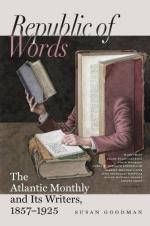But he did not stay long in Scotland; he became gardener for Sir James Douglas, into whose family (below-stairs) he eventually married; afterwards he had experience in the royal gardens at Kew, and in Leicester Fields. Finally he became proprietor of a patch of ground in the neighborhood of London; and his success here, added to his success in other service, gave him such reputation that he was one day waited upon (about the year 1770) by Mr. Davis, a London bookseller, who invited him to dine at an inn in Hackney; and at the dinner he was introduced to a certain Oliver Goldsmith, an awkward man, who had published four years before a book called “The Vicar of Wakefield.” Mr. Davis thought John Abercrombie was competent to write a good practical work on gardening, and the Hackney dinner was intended to warm the way toward such a book. Dinners are sometimes given with such ends even now. The shrewd Mr. Davis was a little doubtful of Abercrombie’s style, but not at all doubtful of the style of the author of “The Traveller.” Dr. Goldsmith was not a man averse to a good meal, where he was to meet a straightforward, out-spoken Scotch gardener; and Mr. Davis, at a mellow stage of the dinner, brought forward his little plan, which was that Abercrombie should prepare a treatise upon gardening, to be revised and put in shape by the author of “The Deserted Village.” The dinner at Hackney was, I dare say, a good one; the scheme looked promising to a man whose vegetable-carts streamed every morning into London, and to the Doctor, mindful of his farm-retirement at the six-mile stone on the Edgeware Road; so it was all arranged between them.
But, like many a publisher’s scheme, it miscarried. The Doctor perhaps saw a better bargain in the Lives of Bolingbroke and Parnell;[A] or perhaps his appointment as Professor of History to the Royal Society put him too much upon his dignity. At any rate, the world has to regret a gardening-book in which the shrewd practical knowledge of Abercrombie would have been refined by the grace and the always alluring limpidity of the style of Goldsmith.
I know that the cultivators pretend to spurn graces of manner, and affect only a clumsy burden of language, under which, I am sorry to say, the best agriculturists have most commonly labored; but if the transparent simplicity of Goldsmith had once been thoroughly infused with the practical knowledge of Abercrombie, what a book on gardening we should have had! What a lush verdure of vegetables would have tempted us! What a wealth of perfume would have exuded from the flowers!
But the scheme proved abortive. Goldsmith said, “I think our friend Abercrombie can write better about plants than I can.” And so doubtless he could, so far as knowledge of their habits went. Eight years after, Abercrombie prepared a book called “Every Man his own Gardener”; but so doubtful was he of his own reputation, that he paid twenty pounds to Mr. Thomas Mawe, the fashionable gardener of the




